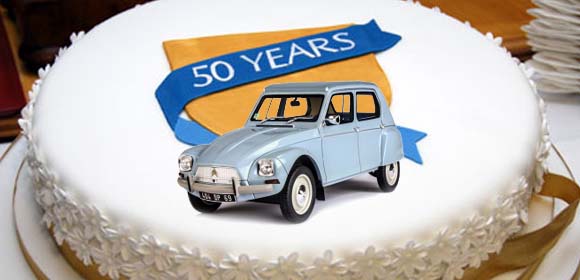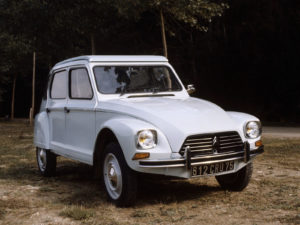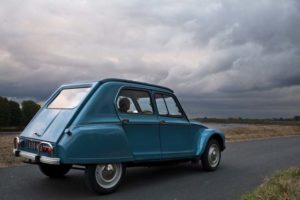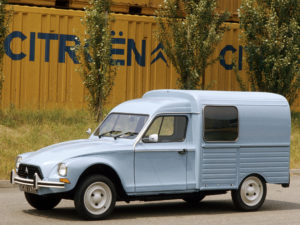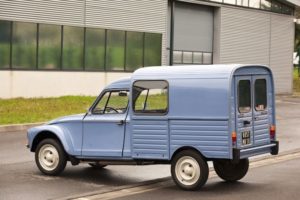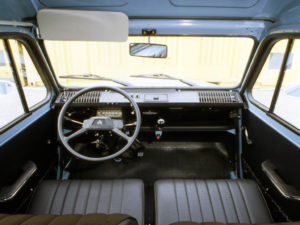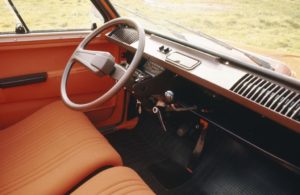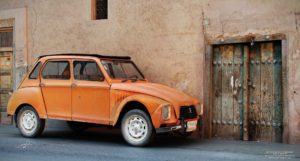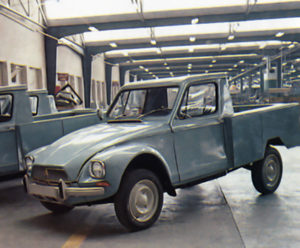In the summer of 1967 Citroën Dyane production started in Rennes, France. The Dyane was Citroën’s answer to the increasingly popular Renault 4 which after its introduction in 1961 had affected 2CV sales. Like the Renault 4, the Dyane was designed from the outset as a four passenger hatchback. It had a sculpted sides and a more angular body than the 2CV. Conventional round headlamps were set into the front fender with a squared stainless steel trim ring (as opposed to the old-fashioned separate units found on the 2CV) and stainless steel wheel covers were standard. Like the 2CV it provided a large folding sunroof but this opened from the inside. (A feature that would come to higher end models of the 2CV later on).
It is often asserted that the Dyane was intended to replace the 2CV, but rather it aimed slightly higher in the Citroën range between the 2CV and the Ami. And Although there was a hatchback option for the 2CV where the rear window roof portion and trunk lid could open as one, the Dyane’s full metal hatchback enclosing the rear window attracted a different clientele seeking its versatility.
At the time of the Dyane’s development, the Citroën design department was busy updating the DS and Ami models, so design of the Dyane was initially subcontracted to the Panhard design department. (Citroën absorbed Panhard’s non-military business in 1965). The Panhard team under Louis Bioner (who had designed every Panhard model introduced between the late 1920s and the mid 1960s), and his assistant Rene-Ducassou Pehau produced a proposal that at a detailed level proved controversial with Citroën’s design chief Robert Opron. Though based on 2CV mechanicals (as was the Ami 6 and the soon to be introduced Méhari) the Dyane was significantly reworked ahead of launch. The Dyane’s Panhard associations are also reflected in its name, Panhard having registered a copyright on the name Dyane along with Dyna, Dynavia and Dynamic. A total of 1,444,583 Dyanes were produced and notably a “truckette” version called the Acadiane of which 253,393 of these light commercial vehicles were built between February 1978 and 1987.
At launch the Dyane was offered with two levels of equipment and trim: The Basic “Luxe” and the slightly better equipped “Confort”. The “Confort” version was differentiated from the outside through the inclusion of hub-caps on the wheels. The spare wheel and jack were mounted in a special cradle under the hood (rather than both simply being placed loose on the floor of the luggage area at the back). The interior of the “Confort” was slightly less basic, with plastic moulded door panels rather than flat, vinyl covered hardboard. The steering wheel was less “rustic” than that which the less expensive “Luxe” version of the Dyane shared with the 2CV. The extra 615 francs in the 1967 domestic market listed price for the Dyane “Confort” represented a supplement of just over 10% when compared to the list price for the more basic “Luxe”.
The Dyane was launched on its home market in August 1967, and for the first five months only the 2CV’s 425cc engine was fitted. The “Dyane 6” was announced at the Brussels Motor Show in January 1968, fitted with the Ami’s 28 bhp 602cc M4 engine and giving it a top speed of 115 km/h (71 mph), which was a useful improvement over the 21 bhp engine and top speed of 100 km/h (63 mph) with which the Dyane had been launched.
The 602cc engine Dyane did not replace the original 425cc engine car. However, two months later, in March 1968, the 425cc unit was replaced by an improved 435cc engine providing 26 bhp in a model called the Dyane 4. The extra power came from changes including not merely the slightly claimed cylinder dimensions, as well as an extra 2 mm of carburetor diameter and a raised compression ratio. Although there was a price to be paid in terms of higher fuel consumption, the listed top speed went up to 105 km/h (66 mph) and acceleration was measurably less anemic. In September 1968 the M4 was replaced by an improved 602cc engine featuring higher compression pistons and forced induction from the engine fan giving slightly more power.
The Dyane was also available with the “trafficlutch” – a centrifugal clutch which helped avoid stalling whilst in slow moving urban traffic.
The Dyane was also built in Iran from 1968 to 1980, where it was called the Jyane – a Persian word meaning “fierce” or “ferocious”. Unique van and pick-up versions were also manufactured there.
